Comptroller Kevin Lembo Archive > News
COMPTROLLER LEMBO PROJECTS BALANCED BUDGET AFTER RESCISSIONSURGES CAUTION ON TIMING OF PLANNED CUTS
In a letter to Gov. Dannel P. Malloy, Lembo said the Office of Policy and Management's (OPM) latest projection is on target - however, he warned that it is still very early in the fiscal year and that significant rescissions might be better timed after the state reaches its non-partisan consensus revenue forecast next month.
All three mitigation plans submitted in Fiscal Year 2015 came after Nov. 19 and totaled a cumulative $100 million, Lembo said.
"Spending cuts may be warranted - but the economic impact of cuts, in this case mostly affecting hospitals, their most vulnerable patients and surrounding communities, may warrant a brief pause until after the state reaches its non-partisan consensus revenue forecast," Lembo said. "Such a delay will allow for additional financial data as October is an important revenue month, while also allowing ample time to control spending as necessary.
"Past practice has been to delay implementation of rescissions until late November - when a clearer picture of revenue receipts emerges through the consensus forecast. I understand the desire to avoid reacting too late and again ending the year in deficit. However, this must be weighed against implementing large cuts to critical programs serving state residents, which may also have an adverse impact on Connecticut's economy as it finally begins to gain traction."
OPM revised its own General Fund revenue projections for Fiscal Year 2016 downward by $96.1 million from last month. Lembo said the largest adjustment is to the income tax, which is reduced by $86.4 million primarily reflecting the recent stock market correction. This, coupled with $6.9 million in additional spending requirements, resulted in the $102.8 million in rescissions. Lembo said the revenue shortfall identified by OPM represents about one-half of 1 percent of anticipated Fiscal Year 2016 General Fund revenue.
"There is no question that current volatility in financial markets has complicated the budget outlook for Fiscal Year 2016," Lembo said. "OPM is utilizing past historical trends to project the impact of the market decline on income tax receipts. This is an accepted and reasonable approach. However, I would note that there has been a dramatic decline in trading volume since the market crash of 2008-09. Households have increasingly moved into index funds and Exchange Traded Funds (ETFs) that some analysts have attributed to the general decline in trading volumes.
"This decline may result in less volatile fluctuations in receipts going forward. I would also note that the fundamentals of the Connecticut economy are strengthening."
Lembo added that, to mark the closing of Fiscal Year 2015, he will host a Fiscal Year 2015 Briefing on Thursday, Oct. 8. Additional details will follow.
Lembo pointed to some of the latest economic indicators from federal and
state Departments of Labor and other sources that show:

• Through August, year-to-date income tax withholding receipts were running
1.6 percent above the same period last year. Implementation of the new tax rate
tables incorporating the higher rate structure, as adopted in PA 15-244, was
required by the end of August. Therefore, the August 2015 receipts do not fully
incorporate the higher rates.
• Withholding receipts are the largest single source of state tax revenue,
accounting for 61 percent of total income tax receipts in Fiscal Year 2015 and
almost 40 percent of total General Fund tax receipts in that year. As the graph
below shows, with the exception of the increases in Fiscal Years 2011 and 2012
that resulted from tax increases, withholding growth has been well below normal
post-recession levels.
• The average annual growth in the withholding tax is approximately 3.5 percent
below the level attained during the last economic recovery period. The below
average wage growth resulted in a state revenue loss of almost $200 million in
Fiscal Year 2015 based on actual receipts data.
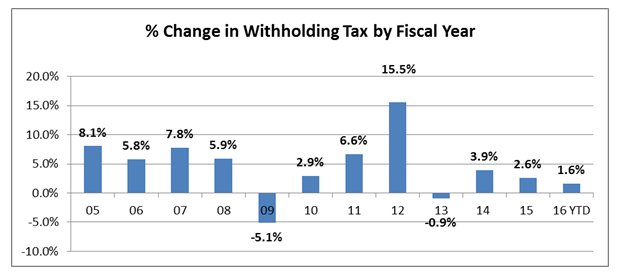
• According to the Department of Labor, preliminary figures show that
Connecticut gained 3,200 payroll positions in August. This follows a revised
July gain of 3,800 jobs. Over the past 12-month period ending in August, the
state has added 33,200 positions due to a steady acceleration in job growth.
• Connecticut has now recovered 104,900 positions, or 88.2 percent of the
119,000 seasonally adjusted total nonfarm jobs that were lost in the state
during the March 2008 - February 2010 employment recession. Connecticut's jobs
recovery is now 66 months old and is averaging about 1,589 jobs per month since
February 2010.
• The state must reach the 1,713,000 job level to enter a full nonfarm
employment expansionary phase. This requires an additional 14,100 nonfarm jobs.
A total of just 1,800 more private-sector positions are needed to have a fully
recovered private sector.
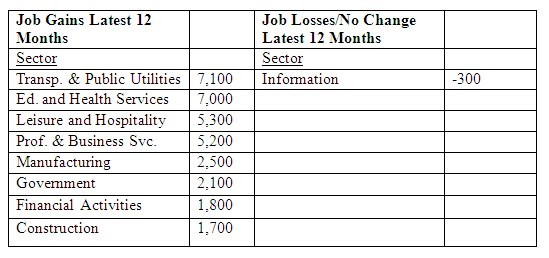
• U.S. employment has been advancing at a rate of 2.1 percent over the
12-month period ending in August; Connecticut's employment growth was 2 percent
for the same period.
• Connecticut's unemployment rate was 5.3 percent in August; the national
unemployment rate was 5.1 percent. Connecticut's unemployment rate has continued
to decline from a high of 9.5 percent in October 2010.
• There are 100,200 unemployed job seekers in Connecticut. A low of 36,500
unemployed workers was recorded in October of 2000. The number of unemployed
state workers hit a recessionary high of 177,200 in December of 2010.
![]()
• The Department of Labor reports that average hourly earnings at $29.24, not
seasonally adjusted, were up $1.26, or 4.5 percent, from the August 2014
estimate. The resultant average private-sector weekly pay was figured at
$991.24, up $45.52, or 4.8 percent higher than a year ago. While this is an
improvement over prior month gains, Connecticut, like the nation, has yet to
establish a pattern of expansionary wage growth.
• The graph below shows the monthly percent change from the prior year in
Connecticut weekly earnings. Connecticut and the nation as a whole have
struggled with stagnant wage growth. This graph provides monthly data through
August 2015.

• Slow wage growth has placed pressure on the state budget, and on the growth
of the larger economy. Household consumption accounts for roughly two-thirds of
the U.S. economy as measured by GDP. During this latest recovery period, GDP has
not attained an annual growth rate of 3 percent or better (although this level
has been attained in certain quarters). Stagnant wage growth has produced lower
than expected gains in consumer spending.
• Based on second-quarter data from the Bureau of Economic Analysis released on
Sept. 30, Connecticut ranks 14th nationally in income growth. The chart below
shows the annual trend in Connecticut personal income over time.

• According to a report from the Warren Group released on Sept. 9, Connecticut single family home sales increased 11.9 percent in July from the prior year. The median sales price for single-family homes in Connecticut in July was $271,000, a 1.4-percent decrease from July 2014's median of $275,000. Sales varied significantly by county.
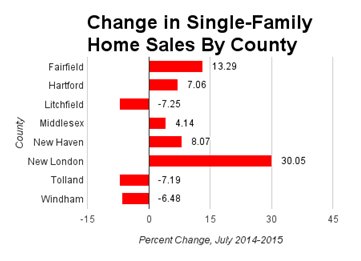
• Year to date there have been 4,215 condo sales, a 9.7-percent increase
compared to the 3,832 transactions through the first seven months of 2014. The
median price year to date has dropped 3.5 percent to $164,000 this year; it was
$170,000 through July 2014.
• Mortgage rates remain at historically low levels.
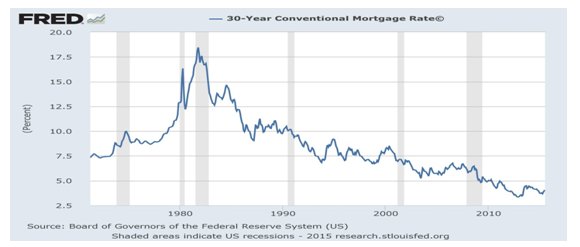
Consumers
• The Commerce Department reported that retail sales, excluding automobiles,
gasoline, building materials and food services—or core retail sales—increased
0.4 percent in August after an upwardly revised 0.6-percent increase in July.
Core sales correspond most closely with the consumer spending component of GDP
and are one indicator that the Federal Reserve examines in setting interest rate
policy. The recent strengthening in core sales point to an improving economic
outlook, and indicate that stock market volatility has not significantly eroded
consumer spending.
• Total retail sales rose 0.2 percent in August as strong gains in auto sales
were offset by a 1.8-percent drop in the value of sales at service stations due
to a decline in gasoline prices. Retail sales for July were revised upward
posting a 0.7-percent gain.
• The University of Michigan Consumer Sentiment Index rose in September.
Consumers increasingly concluded that the stock market declines had more to do
with international conditions than the domestic economy. While the September
Sentiment Index was at the lowest level in 11 months, the trend continues to
point to more confident consumers.
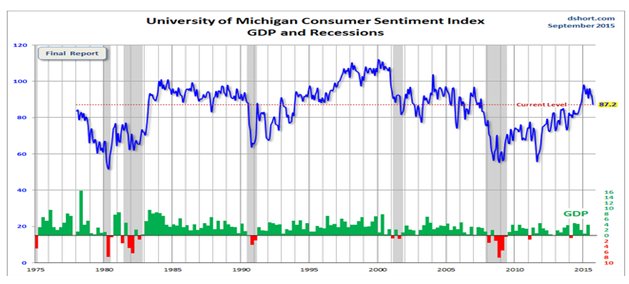
• The Federal Reserve in its Sept. 8 report stated that in July, consumer credit increased at a seasonally adjusted annual rate of 6.75 percent. Revolving credit increased at an annual rate of 5.75 percent, while non-revolving credit increased at an annual rate of 7 percent. This continues an ongoing expansion in consumer borrowing.
Business and Economic Growth
• On Sept. 25, the Bureau of Economic Analysis reported that the third
estimate of GDP in the second quarter of 2015 showed growth of 3.9 percent (up
from the second estimate of 3.7 percent). Growth in the first quarter of 2015
was 0.6 percent. Due to the poor economic performance in the winter, it may be
difficult for GDP to attain a growth rate of 3 percent or better for the year.
• Corporate profits grew by less than 1 percent in the second quarter of 2015
compared to the same quarter last year. Growth in corporate profits did not
exceed 2 percent in 2013 or 2014.
• The Department of Labor's Connecticut Business Totals measures: monthly
movement in housing permits, exports, manufacturing production and hours, air
passenger counts, and gaming slot receipts. As can be seen from the graph below,
during the last recovery the index was uniformly in positive territory. During
this recovery, the results have been mixed.
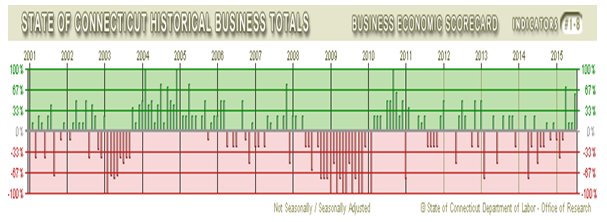
Stock Market
• Estimated and final income tax payments account for approximately 40
percent of total state income tax receipts. These payments show a correlation to
activity in equity markets relating to capital gains.
• Estimated income tax receipts increased 5.3 percent in Fiscal Year 2015
compared to the prior fiscal year. The first significant month of estimated
payment receipts for Fiscal Year 2016 is September. Deposit activity for
September has not been completed as of this writing; however, based on daily
activity to date the estimated payments in Fiscal Year 2016 are close to the
pattern seen in Fiscal Year 2015.
• Over the past several years, the state has experienced significant
fluctuations in capital gains related receipts. In late 2012, investors turned
over a large volume of long-term capital gains to take advantage of the expiring
15-percent tax rate, which increased to a top long-term rate of 23.8 percent
(20-percent rate plus 3.8 percent on AGI above $200,000 related to the ACA) on
Jan. 1, 2013. As a result, the state realized a windfall on the capital gains
driven portion of the income tax in Fiscal Year 2013. Because this left little
in unrealized gains, this component of the income tax experienced a sharp drop
in Fiscal Year 2014. As the market surged, investors were reluctant to take
short-term gains because such gains are taxed at the higher ordinary income
rate. Fiscal Year 2015 estimated and final tax receipts were below initial
budget estimates.
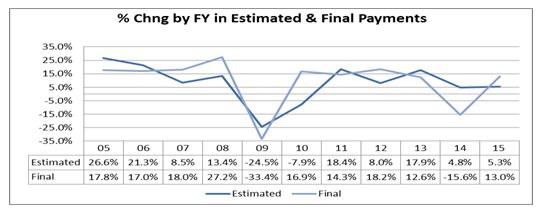
• It is difficult to assess the impact that the current market correction
will have on state revenue given the behavior adjustments that investors have
made in the face of federal tax changes. December/January estimated payment
activity will provide additional data to assess the impact of market activity on
state receipts.
• It is notable that trading volume has been generally declining over the past
decade as can be seen on the chart below. This lower volume provides less
opportunity for dramatic swings in gains. The market correction to date is far
less dramatic than the 2008-2009 collapse. More recently, trading volume has
typically been highest at lower market levels.
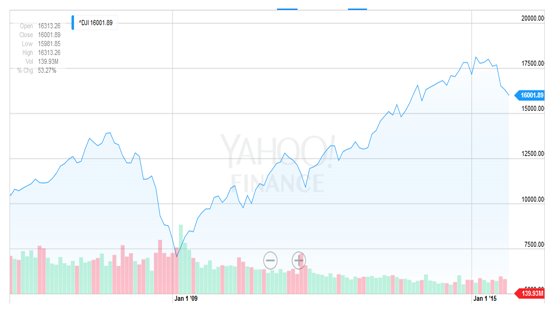
***END***
